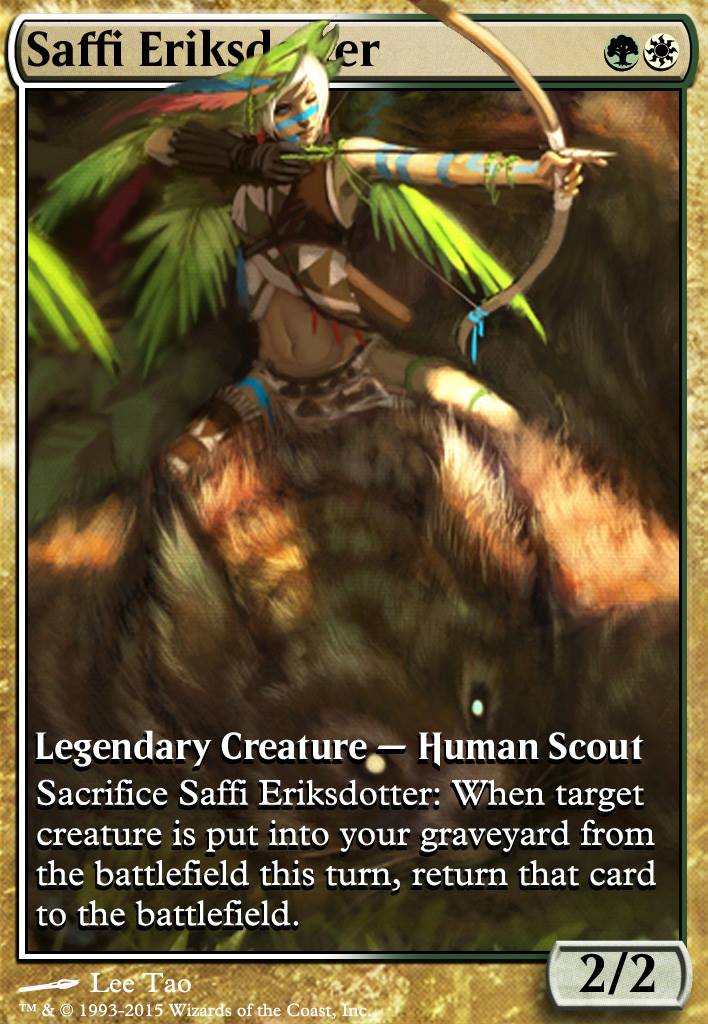
Just Stay Dead (Saffi cEDH)
Commander / EDH Combo Competitive GW (Selesnya) Infinite Combo Primer Reanimator
Creature (35)
-
1x
Arbor Elf

-
1x
Avacyn's Pilgrim

- 1x Birds of Paradise
-
1x
Elvish Mystic

- 1x Esper Sentinel
-
1x
Fyndhorn Elves

- 1x Llanowar Elves
-
1x
Starved Rusalka

- 1x Archivist of Oghma
-
1x
Drannith Magistrate

-
1x
Elvish Visionary

- 1x Grand Abolisher
-
1x
Heart Warden

- 1x Oswald Fiddlebender
-
1x
Outland Liberator
 Flip
Flip
- 1x Priest of Titania
-
1x
Thalia, Guardian of Thraben

- 1x Archon of Emeria
- 1x Aven Mindcensor
- 1x Boromir, Warden of the Tower
- 1x Eternal Witness
- 1x Fiend Hunter
- 1x Loran of the Third Path
- 1x Mentor of the Meek
- 1x Ranger-Captain of Eos
-
1x
Renegade Rallier

-
1x
Skyclave Apparition

- 1x Village Bell-Ringer
- 1x Yisan, the Wanderer Bard
- 1x Academy Rector
- 1x Felidar Guardian
-
1x
Karmic Guide

-
1x
Reveillark

-
1x
Sun Titan

- 1x Woodland Bellower
Land (30)
-
1x
Ancient Tomb

- 1x Arid Mesa
- 1x Boseiju, Who Endures
- 1x Bountiful Promenade
- 1x Branchloft Pathway Flip
-
1x
Brushland

-
1x
Canopy Vista

- 1x Command Tower
- 1x Flooded Strand
- 4x Forest
- 1x Gaea's Cradle
-
1x
High Market

- 1x Horizon Canopy
- 1x Marsh Flats
- 1x Minas Tirith
- 1x Misty Rainforest
- 3x Plains
- 1x Savannah
-
1x
Strip Mine

- 1x Temple Garden
- 1x Verdant Catacombs
- 1x War Room
- 1x Windswept Heath
- 1x Wooded Foothills
- 1x Yavimaya, Cradle of Growth
Enchantment (8)
-
1x
Carpet of Flowers

- 1x Deafening Silence
-
1x
Utopia Sprawl

- 1x Blind Obedience
- 1x Kenrith's Transformation
- 1x Survival of the Fittest
- 1x Sylvan Library
- 1x Greater Good
Sorcery (4)
Commander (1)
Artifact (12)
- 1x Mana Crypt
- 1x Mana Vault
- 1x Skullclamp
-
1x
Sol Ring

- 1x Altar of Dementia
- 1x Arcane Signet
- 1x Liquimetal Torque
- 1x Ashnod's Altar
- 1x Blasting Station
- 1x Phyrexian Altar
- 1x Birthing Pod
- 1x The One Ring
Instant (10)
Maybeboard
Instant (5)
Artifact (2)
Sorcery (5)
Land (2)
Creature (4)
Enchantment (1)
Updates Add
Comments View Archive
Attention! Complete Comment Tutorial! This annoying message will go away once you do!
Important! Formatting tips — Comment Tutorial — markdown syntax
Please login to comment
Revision 172 See all
(7 months ago)
| -1 | March of Otherworldly Light | maybe |
| -1 | Ranger-Captain of Eos | maybe |
| Top Ranked |
|
| Date added | 10 years |
| Last updated | 4 months |
| Legality | This deck is Commander / EDH legal. |
| Rarity (main - side) | 13 - 0 Mythic Rares 55 - 0 Rares 15 - 0 Uncommons 10 - 0 Commons |
| Cards | 100 |
| Avg. CMC | 2.34 |
| Tokens | Day, Illusion */* U, Night, The Ring, The Ring Tempts You |
| Folders | Commander/EDH, Awesome EDH, Decks I Like, edh i like, EDH Options, Watch, Nice Decks, EDH, Personal Decks, Selvala ideas |
| Votes | |
| Ignored suggestions | |
| Shared with | |
| Views |

